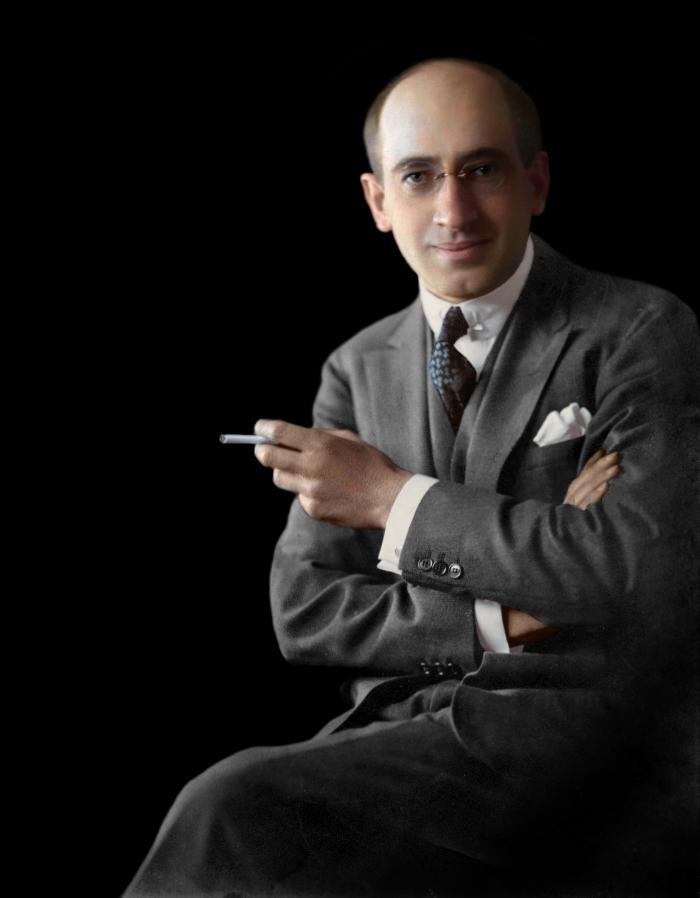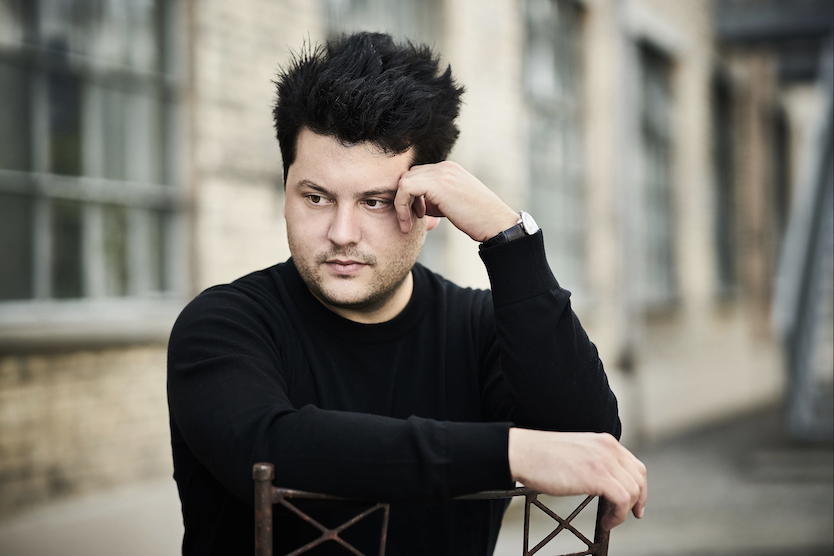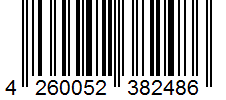Christian Erny
Arthur Lourié: Piano Works
Media Received for Reviewing

2018-07-01 — Original posting
Table of Contents
Introduction
I was proposed reviewing another CD: this time a recording by a pianist—Christian Erny—who is not known very much (yet) even in Switzerland, where he lives. In addition, Christian Erny picked works by a composer—Arthur Lourié—who is largely forgotten. There are only scattered circles of specialists and very few organizations / groups of people who try preserving that composer’s small legacy for posterity.
The Composer: Arthur-Vincent Lourié (1892 – 1966)
Stations in Lourié’s Life
- 1892 — Arthur-Vincent Lourié (actually Naum Izrailevich Luria, later changed into Artur Sergeyevich Luriye) was born into a wealthy Jewish family in Propoysk (Belarus). He converted to Catholicism, and as an admirer of Vincent van Gogh (1853 – 1890), he adopted the name “Vincent”.
- Lourié was partly self-taught, but also studied composition with Alexander Glazunov (1865 – 1936), as well as piano at the Saint Petersburg Conservatory, graduating in 1913.
- Arthur Lourié started composing around 1908—initially adopting the style of Alexander Scriabin (1872 – 1915). He also interacted with painters and writers / poets / novelists of hist time, and
- in composing, by 1914, he had evolved into an early kind of dodecaphony: the Wikipedia article calls him “the first Russian Futurist in music”.
- after the Russian Revolution in 1917, at first, he went by the regime, though appears to have moved away from the new order.
- 1921 he traveled to Berlin, where he became friends with Ferruccio Busoni (1866 – 1924) and never returned to Russia
- 1922 he moved on to Paris, where he met Igor Fyodorovich Stravinsky (1882 – 1971), and
- 1924 – 1931 was one of Stravinsky’s strongest champions. In Paris, Lourié’s compositions moved into neoclassicism—there are speculations that Stravinsky may have adopted features from Lourié’s compositions. Lourié eventually broke with Stravinsky.
- 1940, with the German occupation, Lourié fled to the USA, assisted by Serge Koussevitzky (1874 – 1951). He settled in New York, but didn’t have much success with his compositions.
- 1966, Arthur Lourié died in Princeton, New Jersey.
Oeuvre
From counting Lourié’s works, the majority of his compositions are either for voice and piano, or for piano solo. There are a few orchestral works, some chamber music, a few choral works with and without accompaniment, and one opera. The oeuvre spans the years between 1908 and 1964.
The Artist: Christian Erny (*1988)
Christian Erny’s city of birth is Winterthur, near Zurich. He entered the conservatory in his home town at age six, receiving education on the piano, in choral singing, and in pop music. 2007, after graduating from high school, he continued taking lessons from the ZHdK (Zurich University of the Arts), graduating on the piano, as well as in music pedagogy. He continued his studies at the Jacobs School of Music in Bloomington, Indiana, in the concert class of Jean-Louis Haguenauer (*1954), finishing with the Performer Diploma. Thereafter, Erny complemented his studies by attending master classes with artists such as Leif Ove Andsnes (*1970) and Eldar Nebolsin (*1974) at the Bergen Piano Academy.
Besides his piano education, Erny also studied conducting with Markus Utz at the Zurich University of the Arts. In that segment, he obtained a Certificate of Advanced Studies. At the same time, he started performing in solo and duo recitals, throughout Europe and in the USA. A first CD, released in 2016, featured works by Franz Liszt (1811 – 1886) and Claude Debussy (1862 – 1918). Furthermore, Christian Erny also started directing choirs and is now heading the Zurich Chamber Singers, a professional vocal ensemble of 18 singers which has just released its first CD with works by Thomas Tallis (1505 – 1585), Henry Purcell (1659 – 1695), Kevin Hartnett (*1990), and Johann Sebastian Bach (1685 – 1750).
The CD
Arthur Lourié: Piano Works
Christian Erny, piano
Ars Produktion ARS 38 248 (SACD/DSD/CD, hybrid multichannel stereo/5:1); ℗ / © 2018; Booklet: 24 pp. de/en
Track Listing
- Cinq Préludes fragiles, op.1 (1908 – 1910) — 11’46”
- Lento — 2’39”
- Calme, pas vite — 1’58”
- Tendre, pensif — 2’46”
- Affabile — 1’04”
- Modéré — 3’19”
- Valse (1926) — 4’00”
- Deux Estampes, op.2 (1910) — 10’14”
- Crépuscule d’un faune — 5’32”
- “… Les parfums, les couleurs et les sons se répondent.” — 4’42”
- Intermezzo (1928) — 9’10”
- Petite Suite en fa (1926) — 3’00”
- Gigue (1927) — 4’33”
- Nocturne (1928) — 9’02”
- Eight Scenes of a Russian Childhood (1917)
- Lullaby — 2’27”
Total Duration: 54’11”
The Works in this Recording
About the Selection of Works for the CD
On this CD, Christian Erny initially wanted to give an overview of Lourié’s evolution as a composer. However, he realized that the resulting diversity would be too much, given the limited time / space available. So, he decided to skip the “progressive” / “futuristic” period (around 1913 – 1922). Instead, he focused on two periods in Arthur Lourié’s oeuvre: early piano compositions (op.1, op.2, from 1908 – 1910), and the neoclassical period (1926 – 1928). That alone gives plenty of diversity to cover.
Different from my comments below, the sequence of the pieces on the CD does not strictly follow the chronology of the pieces.
Cinq Préludes fragiles, op.1 (1908 – 1910)
These five short pieces are Lourié’s first “official” compositions for the piano; along with the two from op.2, they are clearly inspired by Claude Debussy:
- Lento
- Calme, pas vite
- Tendre, pensif
- Affabile
- Modéré
How Does it Sound?
All pieces describe a specific mood / atmosphere: they are short, don’t show much development, don’t tell big stories, nor is there any big drama. They all stay within the given atmosphere, don’t even modulate far away from the selected tonality. Even if there is a little “dramatic excursion”, the music returns to and ends in the initial mood.
“Character piece” is the best description that springs to mind—just like some of Debussy’s Préludes. In a way, Lourié’s music in op.1 also reminds me of some of the piano music by Maurice Ravel (1875 – 1937), such as “Le gibet” from “Gaspard de la nuit“, perhaps “Oiseaux tristes” or “La valée des cloches” from “Miroirs“. However, Lourié’s pieces are typically darker in their sound, mostly more somber in the atmosphere. The textures are simpler, less complex, rarely with rapid movements, most often using broken chords rather than full-fingered left hand accompaniment.
And yes, of course: late-romantic Russian composers such as Alexander Scriabin come to mind as well, late works by Franz Liszt, but also Charles-Valentin Alkan (1813 – 1888)…
Comments on the Individual Pieces
- No.1, “slow”, is a somewhat heavy-minded piece—somber, very melancholic, maybe endless sadness, hopelessness. A short climax in the middle leads back to the slow beginning, and also the second, less intense climax leads back to where the thoughts appear to circle around the initial, hopeless memories.
- No.2 is somewhat brighter, somewhat more lively and higher, less dark—a gentle wind blowing in the leaves of a tree, in the dusk…
- No.3, “tender and thoughtful”: lighter than No.1 again, but still with the melancholy that dominates most of this music. A blackbird singing in the silence of the dusk? There is also an occasional, dark undercurrent.
- No.4 is the most serene and most lively of the pieces, even though one can also feel some basic melancholy in the playful figures in the right hand.
- No.5, “moderate”: this returns to the pensive melancholy of the initial piece (almost)—thoughts circling around a somber subject, with memories that temporarily brighten up the mind…
“Images” would be a good title for this little collection—as each of them in a way describes an atmosphere, a static scene. Don’t let the somberness of the atmosphere, the mostly stagnant atmosphere in these pieces turn you down! I actually think, the 16 – 18-year old composer created a set of little masterpieces here! I don’t mind if in his op.1, Lourié imitated French impressionist colleagues—similarities in the atmosphere can also be seen as the spirit of the time, after the turn of the century. And frankly: I would not have guessed that these miniatures are the work of a 16 – 18-year old!
Deux Estampes, op.2 (1910)
Arthur Lourié was 18 when he composed his two Estampes (“stamps”), op.2:
- Crépuscule d’un faune (“Dusk of a Faun”)
- “… Les parfums, les couleurs et les sons se répondent.” (“The fragrances, the colors, and the sounds respond to each other.”)
In these two, somewhat longer pieces, the link to Claude Debussy is most obvious:
- No.1 is clearly linking to the famous “Prélude à l’après-midi d’un faune” (“Prelude to the Afternoon of a Faun”) —just that the afternoon is changed to dusk.
- No.2 is equally directly referring to “Les sons et les parfums tournent dans l’air du soir” (“The sounds and fragrances swirl through the evening air”) from Debussy’s Préludes, Livre I, L.117. That title is a line from the poem “Harmonie du soir” from “Les fleurs du mal” (“The flowers of evil”) by Charles Baudelaire (1821 – 1867).
The cross-links between these pieces and Debussy’s equivalents go way beyond the title / theme: the music indeed resembles its respective role model. However, in my view, it is anything but a copy, or a cheap imitation. Lourié’s style is autonomous and original enough, such that these two pieces can be called masterpieces of their own right. And they are just as atmospheric as Debussy’s “original” models.
Lullaby (1917)
The “Lullaby” is No.6 from the “Eight Scenes of a Russian Childhood” (Roial’ v detskoi) from 1917. That year falls into a time when Lourié already was experimenting with dodecaphony—however, in the “Lullaby”, and probably the entire collection of 8 pieces describing a (his?) Russian childhood, Lourié superficially appears to revive some of the atmosphere from his op.1. However, as appropriate for a lullaby, this music, albeit seemingly dark, is beautifully comforting, unassuming, harmonious, and obviously based upon a Russian song (a Russian lullaby?).
This piece was Christian Erny’s first encounter with Arthur Lourié, played by his teacher in the USA, during his studies. And it captured his attention immediately—enough to make the pianist dig deeper in the archives. “Roial’ v detskoi” apparently translates to “piano in the children’s room”.
Valse (1926)
A waltz, obviously, though not at all as care-free and light-hearted as a typical Viennese waltz (nor is it a caricature like Ravel’s “La valse“). To me, it bears a certain heaviness, clearly some “Russian traits”, and equally some amount of melancholy. Music with originality, and with Lourié’s personality in style, for sure.
Petite Suite en fa (1926)
With this suite (little, indeed!), Erny confronts us with Arthur Lourié, the Neoclassicist—or rather the Neobaroque—composer. One might ask how Lourié can possibly pack a (baroque) suite into as little as 3 minutes. And of course, it isn’t a full Suite in baroque terms. There are four short movements, though without descriptive tempo annotations. Lourié just gives metronome numbers. Interestingly, all four movements use the same basic pace, ♩=176, and all are played attacca:
- (4/4, ♩=176) — a care-free, light movement in A-B-A (or rather A-A’-B-B’-A) form, where the A/A’ parts use baroque textures (a simple, portato melody in the right hand, running staccato quavers in the left), though the harmonies are obviously post-baroque, not far from how Igor Stravinsky adopted (what he thought was) Pergolesi in his Pulcinella ballet & suites. In the middle parts, the pattern changes, the harmonies are more neoclassical, farther away from baroque.
- (2/2, ½=88) — this is neo-classical in the wider sense, rather reminds of a Prélude by Frédéric Chopin (1810 – 1849) in its textures, the mellow legato articulation with the running quaver triplets. The harmonies might be following baroque pattern, though. A lovely piece!
- (4/4, ♩=176) — with this shortest of the segments, the Pulcinella tone / atmosphere is back, also in the somewhat reflective, hesitant second part (Meno mosso) with its ironic turns in harmony (somehow and remotely reminds me of Stravinsky’s early Serenade in A for piano).
- (3/4, ♩=176) — a capricious minuet of sorts—again really close in tone to Stravinsky’s neoclassical works, playful, full of irony, with a slightly melancholic undertone.
Gigue (1927)
Really interesting in its motoric, often syncopated movement that reminds of music by Béla Bartók (1881 – 1945), even Dmitri Shostakovich (1906 – 1975), or—of course—again Stravinsky, though far less percussive than the latter, never provocative, nor ever really harsh. Clearly tonal, though harmonically the most advanced piece so far (in this chronological order). Enthralling music with perseverance and big, grandiose gestures.
Intermezzo (1928)
The Intermezzo begins and ends in a tone close to the restrained, pensive, dark and somber atmosphere of Lourié’s op.1. However, the piece (the longest in this selection) then builds up to quite a dramatic climax, where also the texture is much more dense than in the early works. Clearly, Lourié left the neoclassicism behind. He found back to his own, genuine tone, now in a bigger structure with a large dramatic arch. It’s an impressive, masterful composition—not as an elaborate formal construct, but in its atmospheric development, its grand, overall gesture. The ending to me does not smell of resignation or despair. It rather feels peaceful, despite a short, affirmative, protesting outbreak prior to the final bars.
Nocturne (1928)
Also this is a bigger piece, almost as large as the Intermezzo, though much more diverse in atmosphere, harmonies and tone. And it further moves away from the neoclassicist style.
It starts with a meditative Moderato segment. Its harmonies seem strongly inspired by Alexander Scriabin—far from (neo-)romantic music, far from Stravinsky. But then, the tone changes, and we find ourselves in a calm, true Nocturne (poco più mosso e semplice) that could almost be Chopin’s or Liszt’s (while retaining characteristics of Lourié’s personal style).
The central segment (Molto più mosso) is lively, more dramatic, and harmonically between the “nocturnal segment” and the initial part. After a climax, the music calms down again, returns to “harmonious Nocturne mode”, before the initial Moderato (Tempo I) returns, calming down and fading off ppp in the depth of the keyboard.
Clearly, the Intermezzo and this Nocturne are the true highlights of the CD.
The Performance
Things that strike in Christian Erny’s playing: his excellent and careful, smooth touch, pedaling, and articulation. The latter is accurate, though never overly didactic. Erny shows excellent control in dynamics—he always knows how to make best use of the Steinway grand’s full, round sonority. He obviously has intensely familiarized himself with Lourié’s music, he appears to live in the atmosphere of these pieces. He possesses the necessary calm and control to use diligent rubato and agogics, while never rushing, nor ever dragging. Nothing is ever boring in his playing.
Conclusions
There is no doubt in my mind: as small as his oeuvre may be, Arthur Lourié deserves more attention. Thanks to Christian Erny for digging this out and bringing this composer to our attention!
Acknowledgement
The media for this review were sent to me by Krystian Nowakowski, NO-TE e.U.







